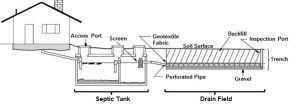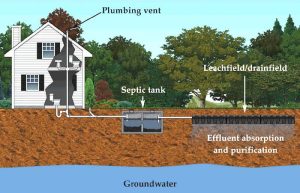





Septic Tanks, Sewer, and Septic Systems in Eastern Ontario
Why Wastewater Systems Matter
Every home needs a reliable way to handle wastewater. In Eastern Ontario, properties in towns and cities are usually connected to municipal sewer systems, while rural and cottage properties typically rely on private septic systems. Both systems are critical to health, safety, and property value, and understanding them is essential for homeowners and buyers.
Municipal Sewer Systems
-
Description: Homes are connected via underground pipes to a city-operated wastewater treatment plant.
-
Pros: Low-maintenance for homeowners, regulated water quality, predictable monthly or quarterly utility fees.
-
Cons: Ongoing costs; homeowners have little control if city systems require repair or expansion.
-
Regional Use: Standard in Belleville, Trenton, Picton, Napanee, and other serviced communities.
Septic Systems
For rural homes across Hastings County, Prince Edward County, Quinte West, and beyond, septic systems are the norm. These are on-site wastewater treatment systems that handle all household sewage.
1. Septic Tank
-
Description: A buried watertight container, usually made of concrete, fiberglass, or plastic.
-
Function: Separates solids from liquids. Solids settle to the bottom (sludge), lighter materials float (scum), and partially clarified liquid (effluent) flows out to the leaching bed.
-
Maintenance: Tanks require pumping every 3–5 years (depending on household size and tank capacity).
2. Leaching Bed (Drain Field)
-
Description: A network of perforated pipes buried in gravel trenches, dispersing effluent into the soil.
-
Function: Soil and natural bacteria further filter and treat wastewater before it returns to the groundwater.
-
Considerations: Requires adequate space and well-drained soil. Heavy traffic, tree roots, or poor drainage can damage the bed.
3. Pump Chambers and Advanced Systems
-
In some cases, septic systems include pump chambers to move effluent uphill or through specialized treatment systems.
-
Advanced Treatment Units (ATUs) may be used in environmentally sensitive areas (e.g., near lakes or rivers), adding aeration or filtration to improve wastewater quality before dispersal.
Common Septic System Types
-
Conventional Gravity System: Effluent flows by gravity from the tank to the leaching bed.
-
Pressurized Distribution System: Uses pumps to evenly distribute effluent, extending system life.
-
Mound Systems: Raised sand and gravel beds used where soil or groundwater conditions aren’t suitable for traditional leaching beds.
-
Holding Tanks: Sealed tanks that store all wastewater for pump-out — typically a last resort, used for cottages or small lots.
Key Considerations for Buyers and Homeowners
-
Inspection: Septic systems should be inspected before purchase. This includes tank condition, bed performance, and signs of backups or leaks.
-
Location: Tanks and beds must be set back from wells, property lines, and water bodies by regulated distances.
-
Usage: Overuse, flushing non-biodegradable items, or pouring grease/chemicals down drains can shorten system life.
-
Lifespan: A properly maintained septic system can last 20–30+ years. Leaching beds often require replacement first.
-
Costs: Pumping typically costs a few hundred dollars, while replacement of a system can run into the tens of thousands.
Regional Perspective
-
Urban Homes: Connected to municipal sewer, with predictable utility fees and little maintenance required.
-
Rural Properties: Most rely on septic systems — buyers should always request pumping/maintenance records and water quality tests.
-
Waterfront and Cottage Properties: May require upgraded or advanced septic systems to protect nearby lakes and rivers.
👉 In summary, Eastern Ontario homes are served by either municipal sewers or private septic systems. Septic systems consist of a tank and leaching bed, sometimes with advanced treatment units, and require regular maintenance to function safely and efficiently. For buyers, knowing the system type, age, and service history is just as important as inspecting the roof or foundation.

